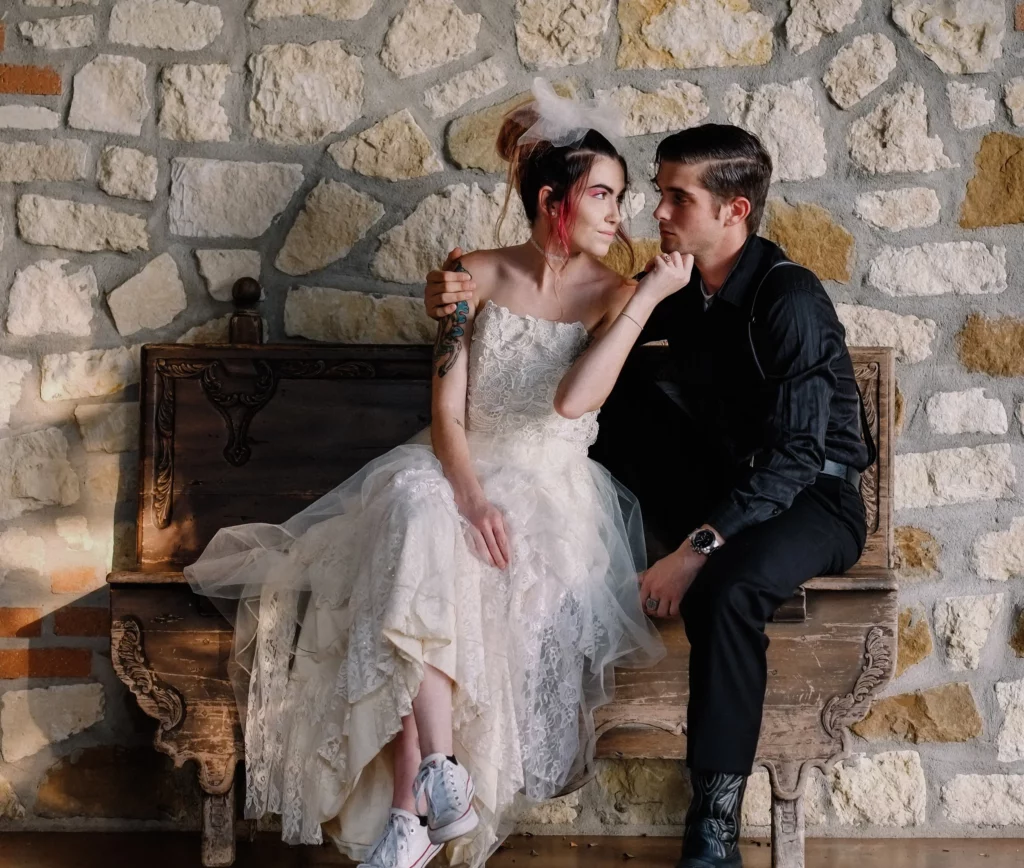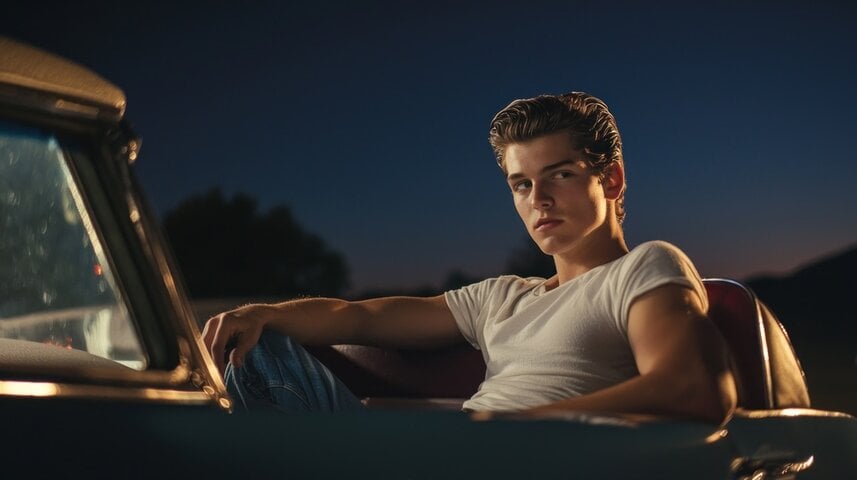Why Rockabilly Still Turns Heads
Rockabilly never really went away; it simply cycles back into focus whenever fashion craves personality, craftsmanship, and clothes that move with music. Born from 1950s youth culture, the look fuses rock ’n’ roll energy with Americana workwear and pin-up polish. In 2025, its revival feels fresh because it rejects disposable trends in favor of defined silhouettes, honest fabrics, and pieces that tell stories. The point is not costume. It is confidence, rhythm, and a wink of rebellion that translates from dance floors to city streets.
The DNA of the Look
Music First, Then Clothes
Rockabilly began as a sound—upright bass slaps, twangy guitars, and quick tempos—so garments were built to swing and snap. Full skirts rise and fall on a beat, cuffed denim holds shape through spins, and jackets frame shoulders without restricting arms. When you start with movement, fit and fabric matter more than logos, and the silhouette reads intentional rather than nostalgic.
Shape Over Shout
The silhouette is the signature: nipped waists, defined shoulders, high rises, and clean lines. For feminine presentations, hourglass tailoring, sweetheart or square necklines, and A-line or circle skirts create momentum. For masculine or androgynous takes, high-rise jeans, short boxy jackets, camp shirts, and Cuban heels elongate the body. The revival keeps these shapes but updates proportions so they feel modern in photographs and in motion.

Fabrics That Age Well
Denim With Character
Selvedge and sturdy twill denims return because they mold to the wearer and fade into one-of-a-kind maps of movement. The 2025 update is comfort without compromise: a touch of stretch hidden inside traditional weaves, or rinses that soften early without erasing long-term patina. Cuffs show selvedge edges, hems crop just above the ankle, and rises sit at the natural waist to lengthen legs.
Cotton, Rayon, Wool, and Leather
Breathable cotton sateens and rayons drape on the dance floor without clinging. Wool gabardine trousers hold a crease and resist wrinkling, perfect for long nights under stage lights. Leather jackets—biker, bomber, or café racer—provide structure and a protective sheen. The rule is simple: pick materials that look better after ten wears than after one.
Color and Print Without Costume
Tonal Neutrals with Pops
Black, ivory, indigo, tobacco, and forest green form the base. Against this canvas, a cherry red scarf, a soft pink cardigan, or a teal bowling shirt becomes a focal point. In daylight, neutrals keep the look grounded; after dark, one saturated accent reads cinematic without turning into theme wear.
Prints with Pulse
Polka dots, micro-gingham, atomic motifs, and camp shirt florals connect directly to mid-century optimism. The modern take tightens scale and controls contrast so the print photographs cleanly. A single patterned piece—shirt, headscarf, or skirt—against quiet companions feels deliberate and wearable.
Tailoring That Moves
The Waist Is Back
High rises are not nostalgia; they are engineering. They set proportions, anchor tucked shirts, and allow clean hip movement. Tailors in the revival scene prioritize waist suppression for jackets and dresses while keeping room through the ribs, seat, and thighs. The result is posture and comfort, not squeezing.
Hemlines for Real Floors
Circle skirts and wide trousers look best when hemmed to float, not fight, the ground. Flats and Cuban heels need space; stiletto-length hems get caught. For denim, cropped or single turn-ups showcase footwear and keep visuals sharp in photos.
Footwear Built for Rhythm
Heels You Can Dance In
Block heels around two inches, wedge sandals, and sturdy Mary Janes combine stability with lift. Cuban heel boots and sleek derbies deliver the same effect for masculine looks. The revival favors leather soles or modern split soles that bend with the foot, carrying you from sidewalk to dance floor without costume changes.
Sneakers with Sense
Low-profile canvas sneakers and retro runners crack the dress code without breaking the spell. Keep lines clean and colors classic so the shoe reads as a period-aware pause rather than a jolt.
Hair, Makeup, and Accessories
Structure Up Top
Victory rolls, brushed-out sets, and polished pompadours persist because they frame faces and hold through movement. The 2025 update is softer edges and humidity-smart products. Hair scarves, bandanas, and satin bows keep styles secure and add color without clutter.
Makeup That Photographs
Winged liner and red or berry lips endure, toned to the complexion and venue light. Skin finishes shift to satin rather than matte chalkiness, and highlighters are placed with restraint so features glow under neon or stage cans without glare.
Jewelry and Small Signals
Pearl drops, hoop earrings, ID bracelets, and slim leather belts communicate an era without shouting. Cat-eye frames, Wayfarer riffs, and narrow sunglasses complete the linework of the face. Each element earns its place; nothing is worn just because it is “period.”
How Designers Are Updating Rockabilly
Modular Pieces
Detachable sleeves, convertible straps, and jackets cut for layering make the look adaptive from daytime markets to late shows. Designers build mix-and-match capsules: a circle skirt that pairs with knit tees or corset tops, a gabardine trouser that shifts from bowling shirt to merino polo.
Inclusive Patterning
Modern pattern blocks recognize different bodies from the first sketch, not as afterthought grading. Strong armholes that do not bite, bust darts that sit where they should, and thigh ease that respects movement keep the style joyful across sizes and genders.
Responsible Materials
Traceable wools, vegetable-tanned leathers, and deadstock rayons deliver the hand and drape the look requires while cutting waste. The sustainability angle fits rockabilly’s root logic: buy well, mend, and wear often.

Scene Culture and Everyday Wear
From Weekender to Wednesday
The current revival separates lifestyle from obligation. You can live in denim, a tee, and a jacket most days and reserve full skirts or tailored minis for parties. Similarly, a camp shirt and high-rise chinos with loafers work at the office; a swap to a leather jacket and open collar takes the fit to a show.
Dance Floors as Fit Labs
Rockabilly lives in motion. Local socials and vintage nights function as laboratories where fits are tested under heat, sweat, and spin. Clothes that survive these conditions look effortless at brunch. If a skirt tangles or a jacket rides up, the pattern needs a tweak—real feedback from real movement.
Styling Playbooks
City Evening
A black circle skirt at calf length, a square-neck knit, and a cropped leather jacket meet Cuban heel ankle boots. Add a slim belt, red lip, and a silk scarf at the neck or wrist. The lines are graphic, the palette restrained, the signals unmistakable.
Daytime Market
Raw indigo jeans with a high rise, a white camp shirt tucked in, and loafers or clean canvas sneakers. Roll sleeves, add a bandana in the hair, and carry a structured tote. The look reads fresh, not fussy.
After-Hours Show
Gabardine trousers with a sharp crease, a rayon bowling shirt half-tucked, and a short suede jacket. Finish with a signet ring and comb-back hair. The silhouette stays vertical and agile for crowded rooms.
Common Missteps and How to Avoid Them
Costume Overload
Head-to-toe replicas flatten personality. Choose one or two strong signals—silhouette and shoe, or hair and jacket—and let the rest sit quietly. If every piece shouts, the outfit stops looking lived-in.
Fit Without Comfort
If you cannot sit, dance, or eat pie, it is not rockabilly. Tailoring must accommodate rhythm. Adjust rises, add seam allowances, and test outfits in motion before the night you care about.
Over-Aging the Look
Distressing everything at once reads forced. Let patina happen where life touches clothes—wallet fade, cuff wear, elbow creases. The story is better when time writes it.
Why the Revival Matters Now
Individuality in an Algorithmic Age
A feed can suggest trends, but it cannot choose your hem length or your favorite song. Rockabilly’s grammar invites authorship within a shared language. Two people can wear the same jacket and look completely different because posture, cuff choice, and music taste influence the result.
Community and Craft
Repair, alteration, and local scenes keep money and meaning close to home. Tailors, cobblers, hair stylists, and small labels thrive when a style rewards longevity. The revival is not just a look; it is an ecosystem.
Final Thoughts
Rockabilly’s modern revival works because it honors movement, silhouette, and story. It replaces disposable novelty with pieces that earn patina, favors fit over flash, and treats music as a design brief. Whether you lean toward pin-up or greaser, androgynous or tailored glam, the goal is the same: clothes that sharpen your outline and let you live at full volume. Wear what dances, keep what ages well, and let the beat decide the rest.
FAQs
Is rockabilly just retro cosplay
No. The revival borrows key shapes and materials but updates proportions, fabrics, and styling. When fit and function lead, the look reads current, not costume.
Can I wear rockabilly elements to work?
Yes. High-rise denim with a tucked knit, a camp shirt with tailored trousers, or a cropped jacket over a simple dress translates easily to offices with smart-casual codes.
Do I need vintage originals?
Not at all. Vintage is wonderful if it fits and holds up, but modern makers cut for contemporary bodies and movement. Blend new and old for the best results.
What shoes make the biggest difference
Stable heels around two inches, Cuban-heel boots, or quality loafers change posture and rhythm immediately. Choose pairs you can stand in for hours.
How do I avoid looking overly themed
Limit overt references and focus on silhouette, fabric, and one strong accent. Keep hair and makeup polished but soft, and choose accessories that earn their place rather than ticking boxes.
